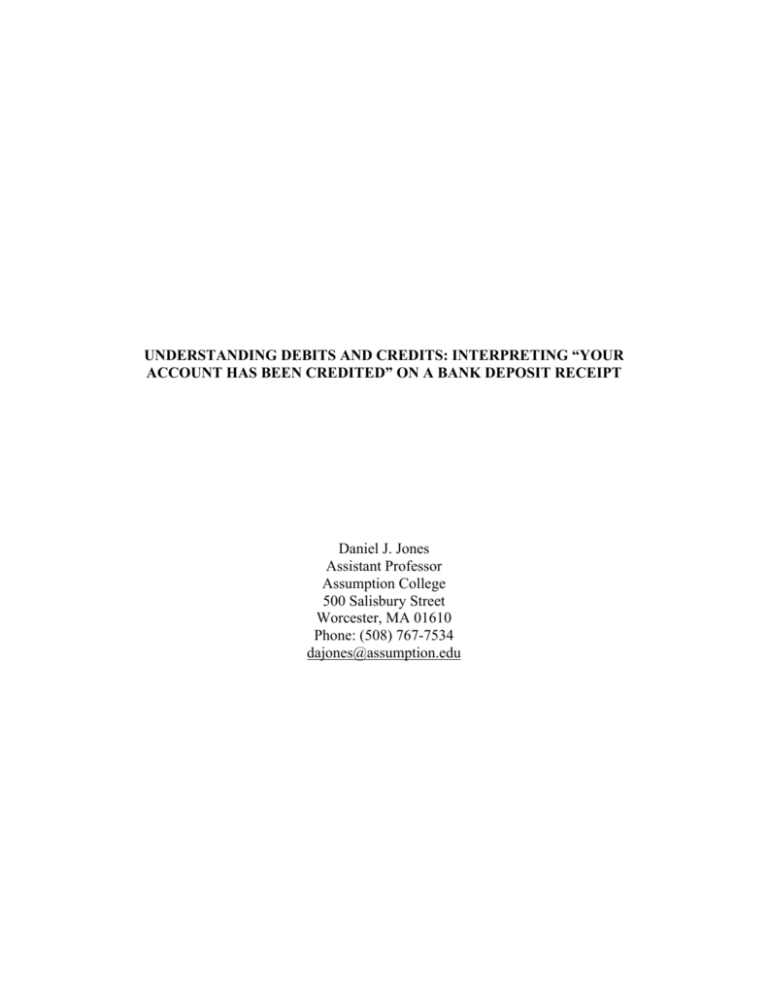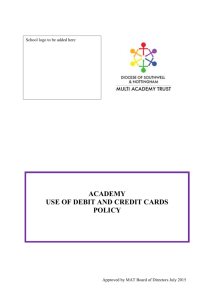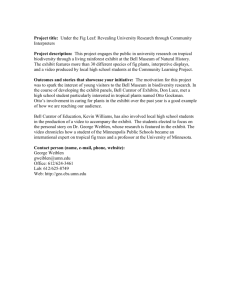Understanding Debits and Credits
advertisement

UNDERSTANDING DEBITS AND CREDITS: INTERPRETING “YOUR ACCOUNT HAS BEEN CREDITED” ON A BANK DEPOSIT RECEIPT Daniel J. Jones Assistant Professor Assumption College 500 Salisbury Street Worcester, MA 01610 Phone: (508) 767-7534 dajones@assumption.edu UNDERSTANDING DEBITS AND CREDITS: INTERPRETING “YOUR ACCOUNT HAS BEEN CREDITED” ON A BANK DEPOSIT RECEIPT INTRODUCTION The main purpose of this teaching resource is to enable students to understand the rules for debits and credits that are summarized in Exhibit 2. Many students are predisposed toward misunderstanding the effect of debits and credits on assets and liabilities. The reason is that they misinterpret what is meant by the words on their receipt when they make a deposit into their bank account. When depositors read, “Your account has been credited,” most assume that the words indicate that Cash has been credited. They are inclined to think that an increase to Cash or any other asset is recorded as a debit. Accounting instructors should address this potential impediment directly. They should clarify this potential obstacle to learning early in the explanations of double-entry accounting systems. This teaching resource enables students to overcome their initial confusion and to properly interpret the meaning of the bank deposit slip. For a bank, receipt of a cash deposit is an increase to the Cash asset and an increase to a liability. Exhibit 3 presents the recording of a bank deposit in two alternative formats: • It records of a transaction on a spreadsheet without using debits and credits on the top, and • It presents debit and credit postings of the same deposit to general ledger T-accounts below. The two formats are linked through the use of arrows that relate the spreadsheet amounts to their postings in the T-accounts. The spreadsheet that is used is referred to as the accounting equation spreadsheet (AESS). When a company records business transactions using the AESS format, processing a transaction keeps the accounting equation (Assets = Liabilities + Owners’ Equity) in balance. BANK DEPOSIT EXAMPLE Recording a Deposit Transaction Using the Accounting Equation Spreadsheet When someone deposits $100 into a savings account at First Bank, the transaction affects the bank accounts in the following way. The bank records an increase in assets, specifically Cash, of $100. Since the bank owes the depositor an additional $100, its liability account, Passbook Liability, also increases by $100. Using the accounting equation spreadsheet (AESS) format, the bank would record the transaction above as shown in Exhibit 1: Recording a Bank Deposit (in AESS Format). Exhibit 1: Recording a Bank Deposit (in AESS Format) Assets = Liabilities Cash + 100 + Owners' Equity Passbook Liability = + 100 Debit and Credit Rules Summary Debits and credits are the means of indicating increases and decreases in account balances. Some accounts are increased by debits, others are increased by credits. Exhibit 2: Debit and Credit Rules, presents the effect of debit and credits on each of the five account types. Note that each account that is increased by a debit is also decreased by a credit, and each account that is increased by a credit is decreased by a debit. Enabling students to understand Exhibit 2 is the main purpose of this teaching resource. Exhibit 2: Debit and Credit Rules Account Type Debit Credit Assets + - Liabilities - + Owners' Equity - + Revenues - + Expenses + - Relationship of General Ledger to Accounting Equation Spreadsheet (AESS) Exhibit 3: Debit & Credit Postings for a Bank Deposit, presents the debit and credit postings for the bank deposit transaction described above. The exhibit builds upon the spreadsheet transaction analysis in Exhibit 1 as the foundation for understanding general ledger T-account postings. Exhibit 3 presents the two alternative methods to record the bank deposit transaction from the perspective of the bank, not the depositor. These alternative formats are: • AESS format: The top half of the exhibit presents the transaction using an accounting equation spreadsheet. Each transaction keeps the A=L+OE accounting equation in balance. • General ledger format: Alternatively, for a bank that uses a general ledger system, the bottom half of Exhibit 3 presents the debit and credit recording of the transaction into the appropriate general ledger T-accounts. Exhibit 3 links the two formats through the use of arrows that relate the spreadsheet amounts in the top half of the exhibit to their postings in the T-accounts in the bottom half. The Meaning of “Your account has been credited.” If someone deposits $100 into a savings account at First Bank, the bank's accounting equation would reflect in increase in assets, specifically Cash, of $100. Since the bank owes the depositor $100, its liability account, Passbook Liability, also increases by $100. Reflecting this transaction as T-account postings, Cash is debited for $100 and Passbook Liability is credited for $100. • The asset Cash is increased by a debit posting. • The liability Passbook Liability is increased by a credit posting. Exhibit 3: Debit & Credit Postings for a Bank Deposit Assets = Liabilities Cash + Owners' Equity Passbook Liability + 100 = + 100 Cash Debit 100 Passbook Liability Credit Debit Credit 100 Note: When you deposit money into your bank account, the deposit slip indicates that your account has been “credited.” To the bank, your account represents the bank’s liability that is owed to you, the depositor. Although the slip does not indicate which account is debited, Cash is debited. UNDERSTANDING DEBITS AND CREDITS: INTERPRETING “YOUR ACCOUNT HAS BEEN CREDITED” ON A BANK DEPOSIT RECEIPT IMPLEMENTATION GUIDANCE Instructors should remember that the main purpose of this teaching resource is to enable users to understand the rules for debits and credits that are summarized in Exhibit 2. The author begins the discussion by writing Exhibit A on the white board. He then asks for student input how to record either part of the transaction. He informs the students that he is class secretary and that there is no penalty for wrong answers. At the conclusion of this activity, Exhibit A is transformed into Exhibit 1 on the board. Exhibit A: Recording a $100 Bank Deposit from Bank’s Perspective Assets = Liabilities + Owners' Equity = With the author continuing to serve as class secretary, he begins the next activity by writing Exhibit B on the board. Exhibit B: Debit and Credit Rules Account Type Debit Credit Assets Liabilities Owners' Equity Revenues Expenses When the activity is completed, Exhibit 2 is on the board. The author begins by asking whether an increase to an asset is recorded with a debit or credit, and then enters the “+” next to “Asset” in the Credit column. He then asks the class to determine where increases (the “+” notations) are recorded for the remaining four account types. After correctly recording the five “+” notations, he enters the minus (-) notations appropriately next to each plus (+). • • • • The following points should be covered during this exercise. Assets are increased by debits. Once this is established, the other rules fall into place. Because the accounting equation (A=L+OE) must always be kept in balance, the rules for liabilities and owners’ equity must be the opposite of the rules for assets. Since revenues represent increases in owners’ equity from operating activities, the rules for revenues are the same as the rules for owners’ equity. Since expenses represent decreases in owners’ equity from operating activities, the rules for expenses are the opposite of the rules for owners’ equity. To tie the concepts together, the author uses the completed Exhibit A that is already on the board. He enhances the exhibit by entering the Cash and Passbook Liability T-accounts, as shown. With student assistance, he enters amounts that transform Exhibit C into Exhibit 3. Exhibit C: Debit and Credit Postings for a Bank Deposit Assets = Liabilities Cash + Owners' Equity Passbook Liability + 100 = + 100 Cash Debit Passbook Liability Credit Debit Credit To conclude the coverage, instructor should read the note below that follows Exhibit 3. Note: When you deposit money into your bank account, the deposit slip indicates that your account has been “credited.” To the bank, your account is their liability that is owed to you, the depositor. Although the slip does not indicate which account is debited, Cash is debited.









